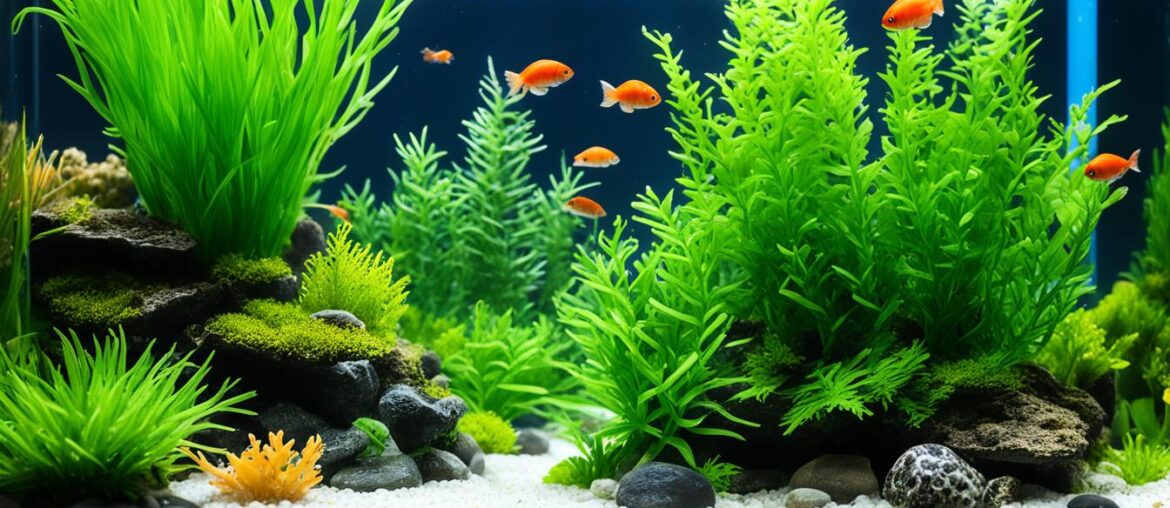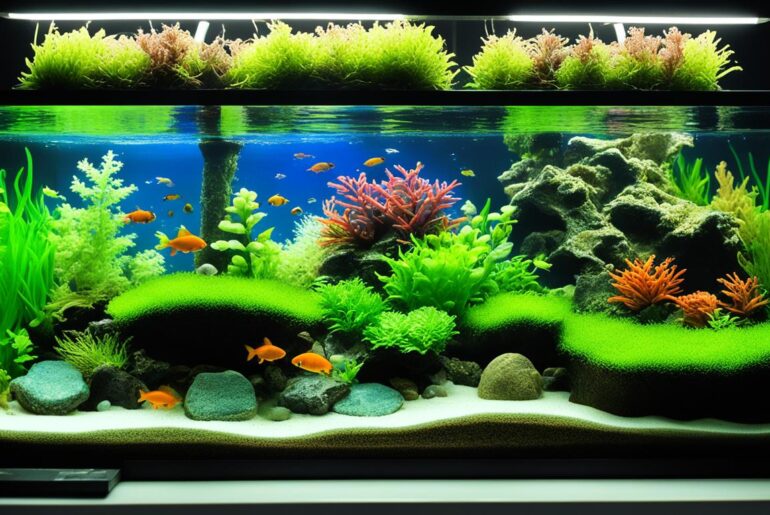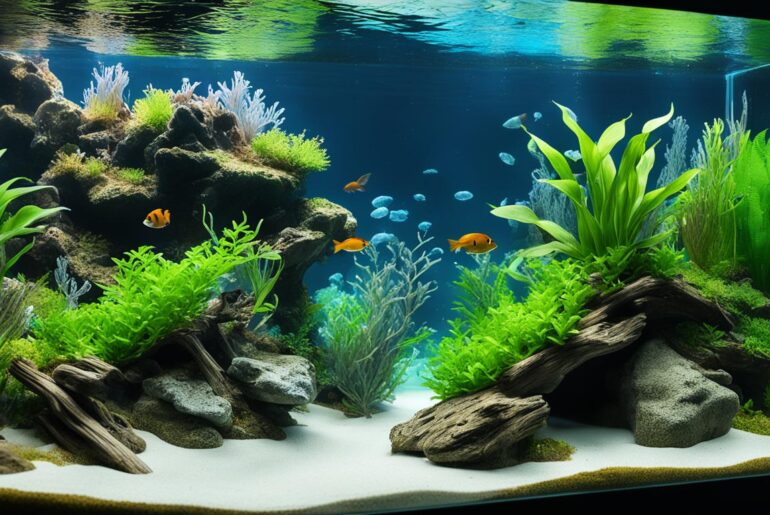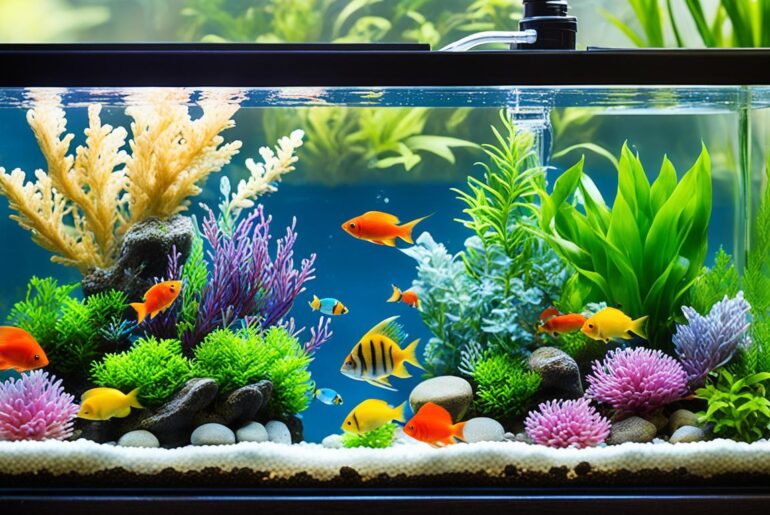As an aquarium enthusiast, I’ve experienced the joy of bringing a new tank to life. The excitement of choosing colorful fish and designing a beautiful underwater habitat is unparalleled. However, I’ve also faced the heartbreak of losing fish due to inadequate tank preparation. It’s a painful lesson that many beginners learn the hard way.
Imagine eagerly introducing your new fish to their new home, only to watch them suffer from ammonia poisoning and succumb to the harsh conditions. It’s a devastating feeling, and one that can be avoided by understanding the importance of cycling your aquarium.
Today, I want to share with you the signs of a fully cycled aquarium and guide you through the fascinating process of the aquarium nitrogen cycle. By the end of this article, you’ll have the knowledge and tools to create a safe and thriving environment for your aquatic friends.
Key Takeaways:
- Understanding the signs of a fully cycled aquarium is crucial for fish health and well-being.
- The aquarium nitrogen cycle is a natural process that converts harmful ammonia into less toxic substances.
- Cycling your aquarium before adding fish helps establish a stable and healthy environment.
- Regular water testing is essential to ensure your tank is fully cycled.
- By following proper cycling methods, you can enjoy a vibrant and thriving aquarium for years to come.
The Importance of Cycling Your Aquarium
Cycling your aquarium is a crucial step that cannot be overlooked before adding fish to your tank. An uncycled tank can lead to harmful health issues for your aquatic pets. Let’s explore the significance of the fish tank cycle, the risk of ammonia spikes, and the role of beneficial bacteria in creating a healthy aquatic environment.
The Fish Tank Cycle: Understanding the Basics
The fish tank cycle refers to the biological process that establishes a balanced ecosystem in your aquarium. It involves the conversion of harmful chemicals, such as ammonia, into less toxic substances, like nitrate. This cycle typically takes four to six weeks to complete.
The Risks of Ammonia Spikes
An uncycled aquarium can experience ammonia spikes. Ammonia is a toxic compound that can build up in the tank due to fish waste and decaying organic matter. High levels of ammonia can be harmful or even fatal to fish, resulting in stress, illness, and death.
“The importance of cycling your aquarium cannot be emphasized enough. Neglecting this crucial step can lead to devastating consequences for your fish.” – Aquarium expert
The Role of Beneficial Bacteria
Beneficial bacteria play a vital role in the aquarium cycle. These bacteria, known as nitrifying bacteria, convert ammonia into nitrite and eventually nitrate. Nitrate is a less harmful compound that can be removed through regular maintenance, such as water changes. Beneficial bacteria colonize the filter media, gravel, and other surfaces in your tank, providing a natural defense against ammonia spikes and creating a healthy environment for your fish.
| Ammonia Levels | Nitrite Levels | Nitrate Levels |
|---|---|---|
| High (Toxic) | High (Toxic) | Low |
| Low | Low | Acceptable |
As shown in the table above, a fully cycled aquarium should have low or zero levels of ammonia and nitrite, while maintaining acceptable nitrate levels. This indicates a healthy and stable environment for your fish.
By understanding the importance of the fish tank cycle, the risks of ammonia spikes, and the pivotal role of beneficial bacteria, you can ensure the well-being of your aquatic pets. Remember to cycle your aquarium properly before introducing any fish, providing them with a safe and thriving habitat.
Methods to Speed Up the Cycling Process
If you want to speed up the cycling process of your aquarium, there are a few effective methods you can implement. These methods involve fishless cycling, the use of aquarium bacteria supplements, and the utilization of existing tank filtration media.
Fishless Cycling: One way to accelerate the cycling process is through fishless cycling. This method involves the addition of organic material, such as fish food, to the tank to produce ammonia. The organic material decomposes and releases ammonia, which stimulates the growth of beneficial bacteria. These bacteria will convert the ammonia into nitrite and eventually nitrate, establishing a stable nitrogen cycle in the tank.
Aquarium Bacteria Supplement: Another effective method is to use an aquarium bacteria supplement. These supplements contain specially formulated strains of beneficial bacteria that can be directly added to the tank’s water. These bacteria help colonize the tank and expedite the development of the nitrogen cycle by efficiently converting ammonia and nitrite.
Existing Tank Filtration Media: Utilizing existing tank filtration media can also speed up the cycling process. If you have a well-established and cycled tank, you can transfer some of the existing filter media to the new tank. The filter media contains a vast population of beneficial bacteria, which can quickly establish in the new tank and kickstart the nitrogen cycle. However, ensure the existing tank is free from any diseases or harmful bacteria before transferring the filter media.
Tips: When employing any of these methods, it is crucial to regularly monitor the ammonia, nitrite, and nitrate levels to determine the progress of the cycling process. Additionally, maintain a stable temperature and provide adequate aeration to support the growth of beneficial bacteria.
| Method | Description |
|---|---|
| Fishless Cycling | Add organic material to produce ammonia and stimulate the growth of beneficial bacteria |
| Aquarium Bacteria Supplement | Introduce beneficial bacteria directly into the tank to accelerate the establishment of the nitrogen cycle |
| Existing Tank Filtration Media | Transfer filter media from a cycled tank to introduce established bacterial colonies to the new tank |
Benefit of Using Existing Tank Filtration Media
One of the advantages of utilizing existing tank filtration media is the rapid colonization of beneficial bacteria in the new tank. By introducing established bacterial colonies, the cycling process can be significantly sped up, allowing for the quicker establishment of a stable nitrogen cycle. This method is especially useful when time is a constraint or when dealing with delicate or sensitive fish species that require a stable environment.

Factors That Can Slow Down the Cycling Process
Several factors can impede the nitrogen cycle in an aquarium, prolonging the cycling process. It’s crucial to be aware of these factors to ensure a smooth and efficient cycling phase. The three main factors that can slow down the cycling process are:
- Water pH: A low water pH level, below 7.0, can hinder the growth and activity of beneficial bacteria responsible for converting ammonia to nitrite. To maintain an optimal pH level, perform a 20% water change if the pH falls below 7.0.
- Pure Ammonia Levels: Excessive levels of ammonia, surpassing 5ppm, can be toxic to beneficial bacteria. This toxicity can lead to a stall in the cycling process. Regularly test ammonia levels using a reliable testing kit and perform a partial water change if necessary to keep ammonia levels in check.
- Overfeeding Fish: Overfeeding fish can result in excess food waste and uneaten food, leading to high ammonia levels. These elevated ammonia levels overwhelm the filtration system, hindering the cycling process. It’s important to feed fish the appropriate amount and remove any uneaten food promptly.
By addressing these factors and maintaining optimal water conditions, you can help expedite the cycling process and ensure a healthy and stable environment for your fish.
Expert Tip:
“Regular monitoring of water pH and ammonia levels, along with responsible fish feeding practices, are key to maintaining a favorable environment for beneficial bacteria and a successful aquarium cycling process.”
| Factors | Effects on Cycling Process |
|---|---|
| Low Water pH (below 7.0) | Hinders growth of beneficial bacteria |
| Excessive Ammonia Levels (above 5ppm) | Can stall the cycling process |
| Overfeeding Fish | Leads to high ammonia levels and overwhelms the filtration system |
Introducing Fish to a Cycled Aquarium
Now that your tank is fully cycled, it’s time to add fish and bring your aquarium to life. However, it’s crucial to introduce fish gradually to ensure the success of your tank’s beneficial bacteria colonies.
I recommend starting with a couple of small fish and closely monitoring the water parameters. Test the ammonia and nitrite levels daily to ensure they remain within acceptable ranges. This cautious approach allows the beneficial bacteria to adjust to the increased bio-load, ensuring a stable and healthy environment for your new fish.
Gradual Fish Addition
Once you’ve successfully introduced the initial fish and established stable water parameters, you can gradually add more fish over time. This gradual approach helps maintain the delicate balance within your aquarium and prevents overcrowding.
Overcrowding is a common mistake that can lead to poor water quality and stressed, sick fish. It’s essential to consider the specific needs of each fish species and their compatibility when adding them to your tank.
Monitoring Water Parameters
Continual monitoring of water parameters is essential even after fish addition. The introduction of new fish can disrupt the balance, impacting ammonia and nitrite levels. By diligently testing the water, you can address any spikes or fluctuations promptly.
Here is a quick reference guide for ideal water parameters:
| Water Parameter | Ideal Range |
|---|---|
| Ammonia | <0.25ppm |
| Nitrite | <0.05ppm |
| Nitrate | <30ppm |
Regular testing and maintaining these parameters will ensure the continued health and well-being of your fish.
Preventing Overcrowding
Overcrowding can have detrimental effects on your fish and the overall health of your aquarium. It’s important to consider the adult size and behavior of each fish species to determine the appropriate stocking density. A general guideline is to provide at least one gallon of water per inch of fully grown fish.
Avoiding overcrowding allows for better water quality, minimizes territorial disputes, and reduces stress on the fish. It also provides ample swimming space for active fish species, promoting natural behaviors and overall well-being.
Remember, a well-managed and thriving aquarium is a delicate balance of fish, beneficial bacteria, and water parameters. Take your time when adding fish to your cycled aquarium, and always prioritize the health and happiness of your aquatic inhabitants.

How to Know if Your Aquarium Is Fully Cycled
To determine if your aquarium is fully cycled and providing a healthy environment for your fish, it is essential to perform regular water tests and observe the well-being of your fish. By monitoring water parameters and keeping an eye on the behavior of your fish, you can ensure that your aquarium is properly balanced and fish-friendly. Here are the key steps to determine if your aquarium is fully cycled:
1. Perform Water Testing: Regularly test the water in your aquarium using a reliable testing kit. This will provide accurate readings of the ammonia, nitrite, and nitrate levels in your tank. Proper water testing is crucial as it allows you to assess the progress of the nitrogen cycle in your aquarium and identify any potential issues.
2. Check Ammonia Levels: In a fully cycled aquarium, the ammonia levels should be at zero parts per million (ppm). Elevated levels of ammonia can be toxic to fish and indicate an uncycled tank. Regularly test for ammonia to ensure a safe and healthy environment for your fish.
3. Monitor Fish Health: The well-being of your fish can also serve as an indicator of a fully cycled aquarium. In a properly cycled tank, fish will exhibit active behavior, have a good appetite, and show no signs of sickness or stress. Observe your fish closely and look for any unusual behavior or visible signs of illness.
Additionally, here is a table summarizing the ideal water parameters for a fully cycled aquarium:
| Parameter | Ideal Level |
|---|---|
| Ammonia | 0 ppm |
| Nitrite | 0 ppm |
| Nitrate | Below 30 ppm |
By regularly testing your water, monitoring ammonia levels, and observing fish health, you can confidently determine if your aquarium is fully cycled. Remember, a fully cycled aquarium provides a safe and thriving environment for your fish.
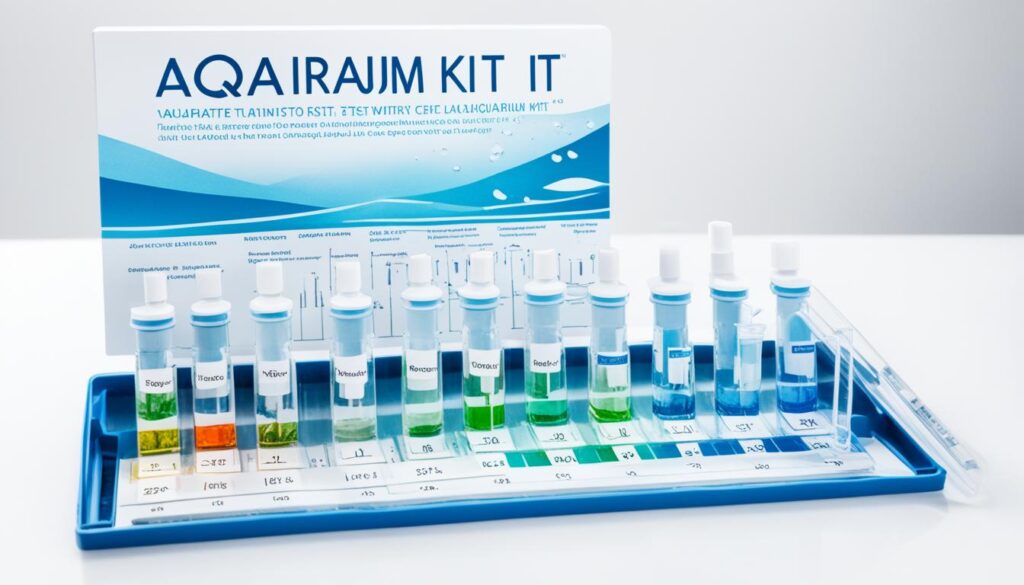
Cycling a Saltwater Aquarium
Saltwater aquariums undergo a similar cycling process as freshwater tanks. It is important to establish a stable environment before adding any marine life. Let’s explore some key indicators of a fully cycled saltwater tank.
Healthy Algae Growth
A well-cycled saltwater tank exhibits signs of healthy algae growth. One particular type to look out for is red coralline algae. This variety is beneficial as it competes with other algae and provides a natural and attractive red coloration to the tank’s surfaces. When red coralline algae begins to overtake other types of algae, it signifies a well-balanced and mature saltwater aquarium.
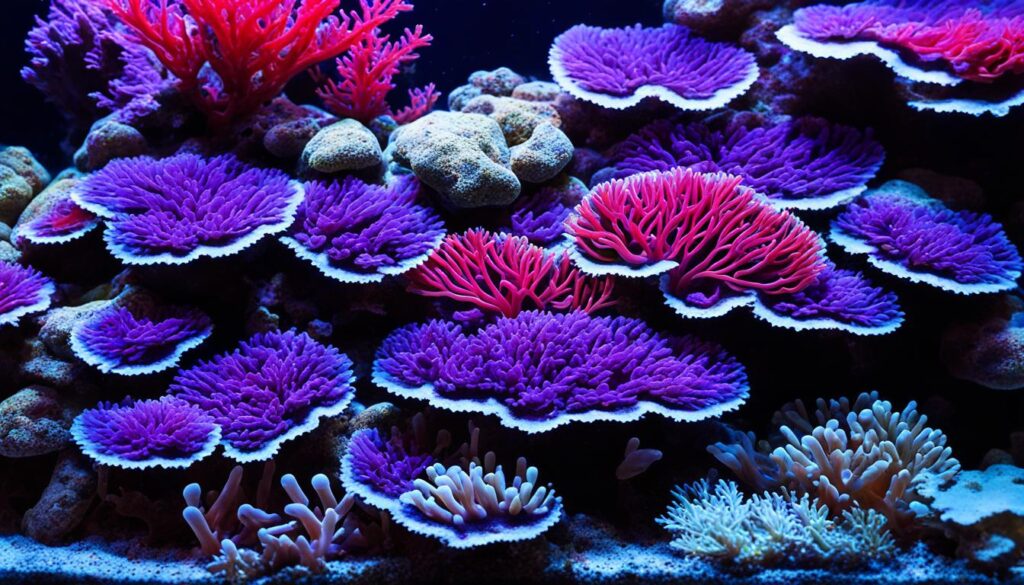
Presence of Small Aquatic Bugs
If you notice the appearance of small aquatic bugs in your saltwater tank, it is a positive indication that the ecosystem is thriving. These bugs often hatch from eggs present in rocks, live rock, or other items introduced into the tank. While they may seem small and insignificant, their presence confirms a healthy saltwater aquarium.
Sponges and Burrows in the Substrate
An additional sign of a cycled saltwater tank is the presence of sponges and burrows in the substrate. Sponges are essential as they help maintain water quality by filtering out impurities. Aquatic burrowers, such as certain types of crabs and shrimps, play a role in regulating the ecosystem by aerating the substrate. These indications demonstrate the establishment of a stable and well-functioning saltwater aquarium.
By observing these signs in your saltwater tank, you can ensure that the cycling process has been successful, and your marine life will thrive in a healthy environment.
Considerations for Adding Plants to an Aquarium
When it comes to creating a beautiful and thriving aquarium, adding live plants can enhance the overall aesthetics and provide numerous benefits for your aquatic environment. Whether you choose to incorporate plants before or after the cycling process, there are a few considerations to keep in mind.
Ammonia Levels: It’s important to note that live plants release ammonia as a natural part of their metabolic processes. This can potentially affect the cycling process if you’re adding pure ammonia to your tank. However, in a fully cycled tank, the presence of live plants typically does not significantly impact ammonia levels.
Compatibility: When selecting aquarium plants, it’s crucial to consider their compatibility with the fish species in your tank. Some plants may require specific water conditions or lighting, so research the preferences of your chosen plants to ensure they can thrive in your setup.
Benefits: Incorporating live plants into your aquarium not only enhances its visual appeal but also provides several additional benefits. Plants help oxygenate the water, improving the overall health of your fish. They also serve as natural filtration systems, assisting in the removal of nitrates and other toxins. Plus, many fish species appreciate having plants in their environment as they provide hiding spots and simulate their natural habitats.
To give you a better idea of the various types of aquarium plants available and their specific care requirements, here’s a table highlighting some popular choices:
| Plant Name | Scientific Name | Water Temperature | Lighting Requirement |
|---|---|---|---|
| Anubias | Anubias barteri | 72-82°F (22-28°C) | Low to medium lighting |
| Java Fern | Microsorum pteropus | 68-82°F (20-28°C) | Low to medium lighting |
| Dwarf Hairgrass | Eleocharis parvula | 68-82°F (20-28°C) | Medium to high lighting |
| Amazon Sword | Echinodorus bleheri | 68-82°F (20-28°C) | Medium to high lighting |
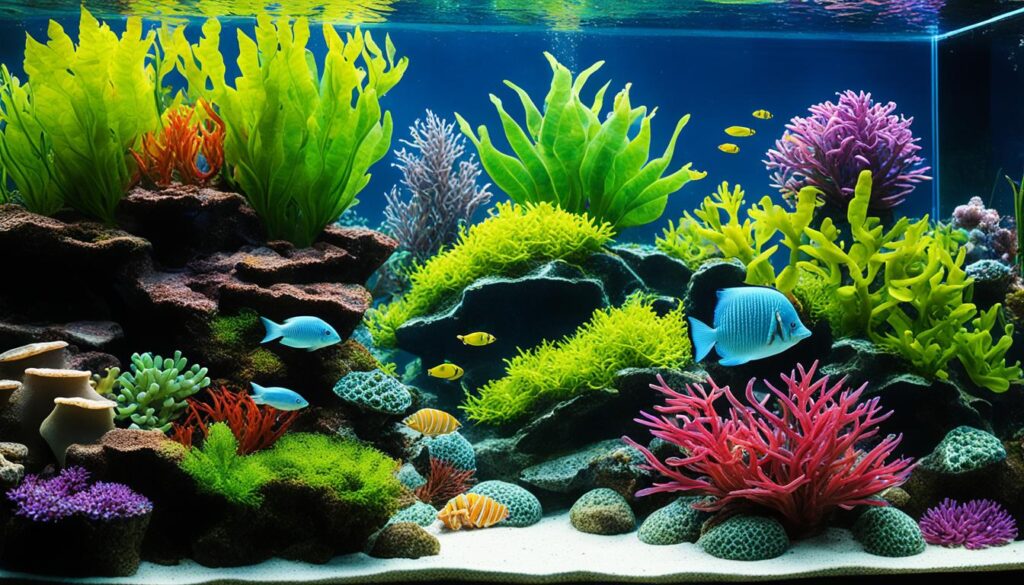
As you can see, there is a wide variety of aquarium plants to choose from, each with its own unique characteristics and care requirements. Take your time to research and select the plants that best suit your aquarium’s parameters and the needs of your fish.
Conclusion
Cycling your aquarium is essential for creating a healthy and thriving environment for your fish. By testing the water parameters, monitoring ammonia levels, and observing the well-being of your fish, you can determine if your tank is fully cycled. Understanding the signs of a cycled aquarium allows you to provide optimal care for your aquatic life.
Through patience and proper maintenance, you can establish a balanced ecosystem that promotes the overall health and happiness of your fish. Regular water testing using reliable testing kits is crucial to ensure that ammonia and nitrite levels are at zero, while nitrate levels are below 30ppm. This confirms that your tank has completed the nitrogen cycle and is safe for fish.
By following the cycling process diligently, you can avoid the risks of ammonia poisoning and create an environment that supports the well-being of your fish. Remember to introduce fish slowly and avoid overcrowding the tank to maintain stable water parameters. With a cycled aquarium, you can enjoy the beauty of your fish while providing them with a safe and healthy habitat.
FAQ
How can I determine if my aquarium is fully cycled?
To determine if your aquarium is fully cycled, test the water for ammonia, nitrite, and nitrate levels. If the ammonia and nitrite levels are zero and the nitrate levels are less than 30ppm, your tank is cycled.
Why is cycling my aquarium important?
Cycling your aquarium is important because it allows beneficial bacteria to colonize, which converts ammonia into nitrite and then nitrate. This process establishes a healthy environment for fish and prevents ammonia poisoning.
How can I speed up the cycling process of my aquarium?
You can speed up the cycling process by adding organic material like fish food to produce ammonia or using an aquarium bacteria supplement. Another method is using existing filter media from a cycled tank to introduce established bacterial colonies.
What factors can slow down the cycling process?
Low water pH, excessive ammonia levels, and overfeeding fish can slow down the cycling process. Maintaining proper water parameters and performing regular water changes can help prevent these issues.
How should I introduce fish to a fully cycled aquarium?
It is recommended to introduce fish gradually to avoid overwhelming the beneficial bacteria colonies. Start by adding a couple of small fish and monitor the water parameters daily. If everything remains stable, you can gradually add more fish over time, avoiding overcrowding.
How can I know if my aquarium is fully cycled?
Regularly test the water using a reliable testing kit. Ammonia levels should be at zero ppm, along with nitrite levels. Nitrates should be below 30ppm. Additionally, observe the health and behavior of your fish for signs of sickness or stress.
How do I cycle a saltwater aquarium?
Cycling a saltwater aquarium follows a similar process as freshwater tanks. Look for signs of healthy algae growth, small aquatic bugs, and the presence of sponges and burrows in the substrate.
Should I add plants before or after cycling my aquarium?
You can add plants before or after cycling your aquarium. Plants release ammonia, which can affect the cycling process if using pure ammonia. However, the presence of plants does not significantly impact ammonia levels in a cycled tank, and they provide additional benefits such as oxygenation and natural filtration.
What are the considerations for adding plants to an aquarium?
When adding plants, consider their compatibility with the fish species in your aquarium. Live plants offer benefits such as oxygenation and natural filtration.
